Menus
- Racy athlete meets strong all-rounder
- Ducati’s best-selling was the Scrambler
- Choke lever sits on the handlebar
- Full hub brakes are not much good
- The Desmo engine runs much quieter
- Street models in 1971 split into two rows
- Technical data Ducati Scrambler 450 / Ducati Desmo 450
- In the check – technology, market, dealers
- technology
- Purchase check
- market
- Specialists
- history
- Opinions
- Fred Siemer
- Michael Scheidner
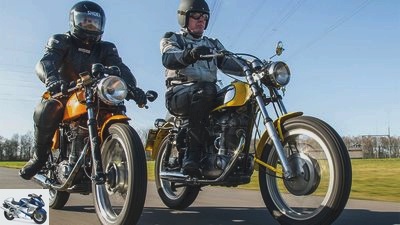
Rivas
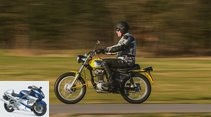
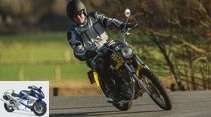
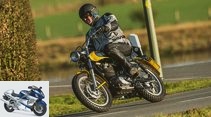
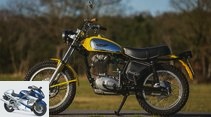
33 photos
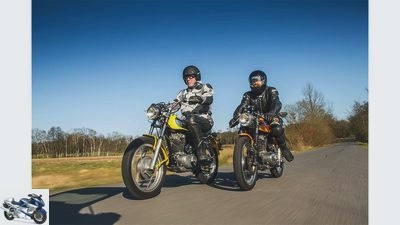
Rivas
1/33
Ducati Scrambler 450 and Ducati Desmo 450 on a joint ride.
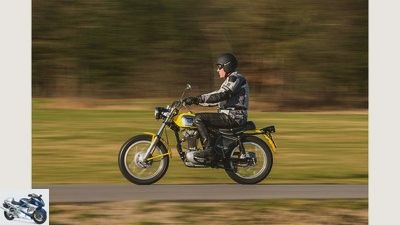
Rivas
2/33
Just looking at it makes it clear: The Ducati Scrambler 450 is a street motorcycle …
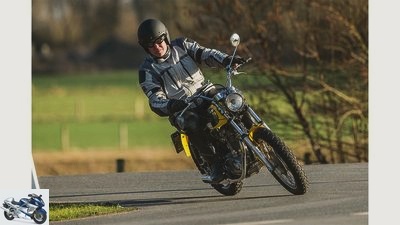
Rivas
3/33
But because it’s a pretty light one, the studded tires make sense every now and then.
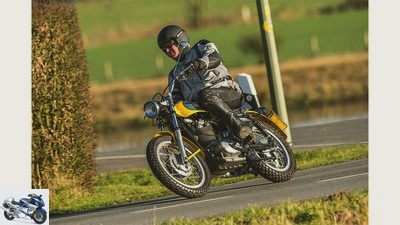
Rivas
4/33
It is completely practical …

Rivas
5/33
… their characteristic air filter box.
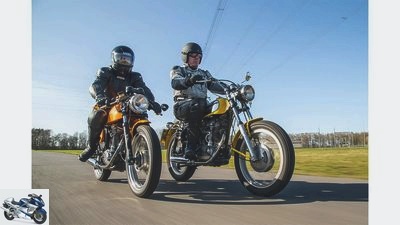
Rivas
6/33
Ducati Desmo 450 and Ducati Scrambler 450.
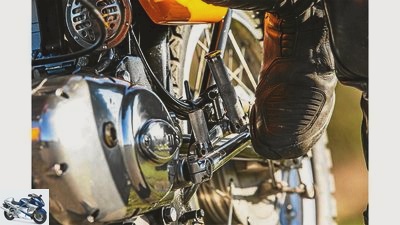
Rivas
7/33
Precision work is required before the energetic step: the footrest and brake pedal must be folded in.
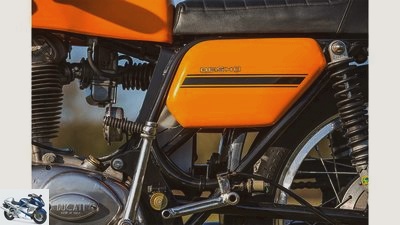
Rivas
8/33
Ducati Desmo 450.
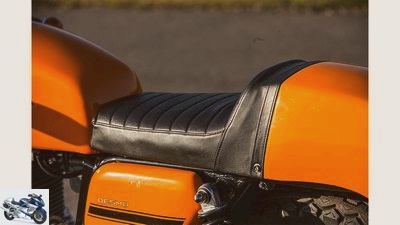
Rivas
9/33
Ducati Desmo 450.
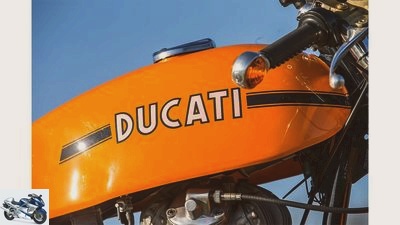
Rivas
10/33
Ducati Desmo 450.
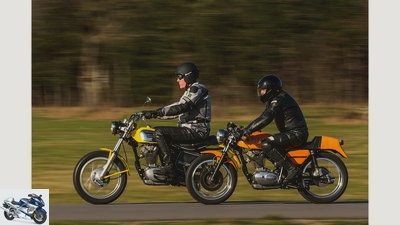
Rivas
11/33
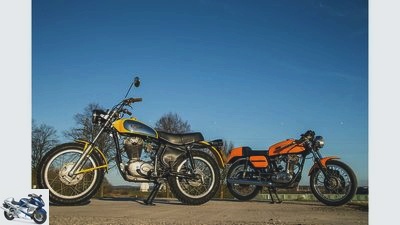
Rivas
12/33
Ducati Desmo 450 and Ducati Scrambler 450.
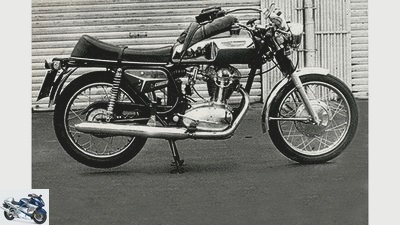
Rivas
13/33
1969: The 450 makes its debut, both street and scrambler versions. At the same time, a – never produced – 500 parallel twin with an underneath camshaft was also being developed, hence the displacement restriction.
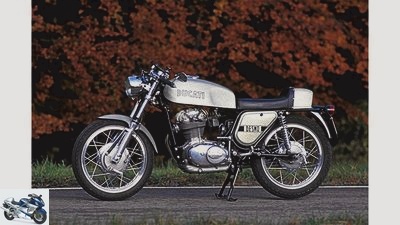
Rivas
14/33
1971: The Desmo 250 to 450 models appear radically sporty
and position themselves at the top of the Ducati single-cylinder range.
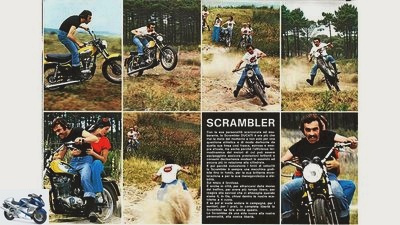
Rivas
15/33
In the beautiful world of color brochures, the Scrambler turned into a terrain monster. That was enough to become the best-selling Ducati in Italy and the USA for a few years.
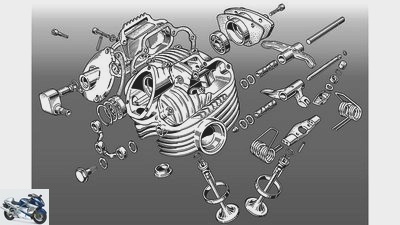
Rivas
16/33
The cylinder head and vertical shaft drive of a Desmo single consist of around 200 individual parts. This exploded view shows its control side, it is very nice to see the complicated precision mechanics required by the closers of the valves. The hairpin springs are mainly used to safely close the valves before starting.
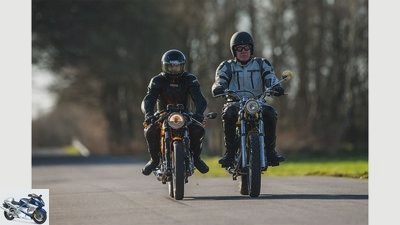
Rivas
17/33
After a day with Ducati’s single cylinders …
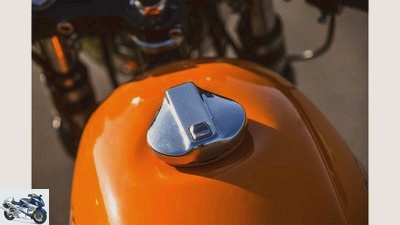
Rivas
18/33
Ducati Desmo 450.

Rivas
19/33
Show quite well and look very good: the little Smiths watches.
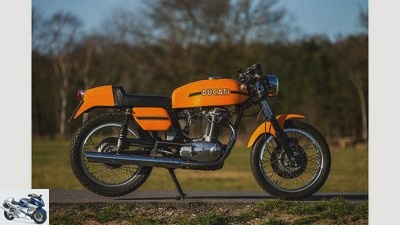
Rivas
20/33
Of course, the Ducati Desmo 450 came to Germany from the factory without indicators.
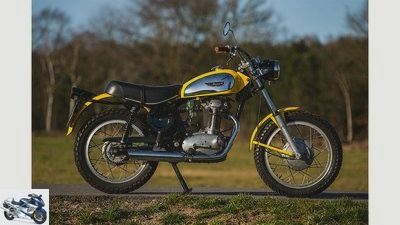
Rivas
21/33
… their characteristic air filter box.
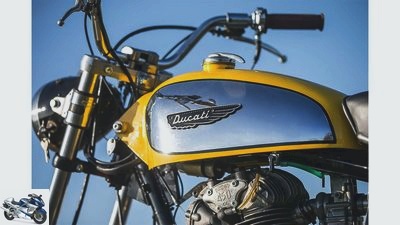
Rivas
22/33
Ducati Scrambler 450.
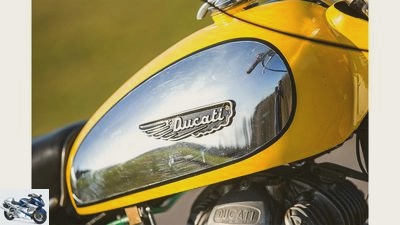
Rivas
23/33
A few details were enough for the designers, …

Rivas
24/33
to make the Ducati Scrambler 450 stand out from the crowd and …
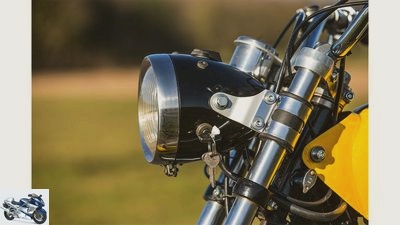
Rivas
25/33
… to make them valuable.
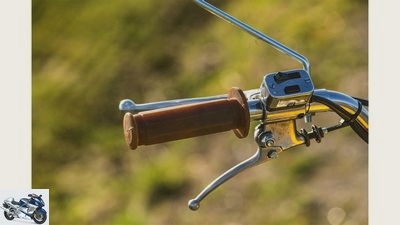
Rivas
26/33
The decoration lever also underlines the friendly nature of this Duc.
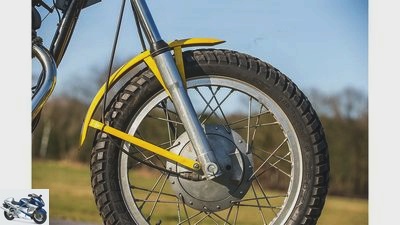
Rivas
27/33
Ducati Scrambler 450.
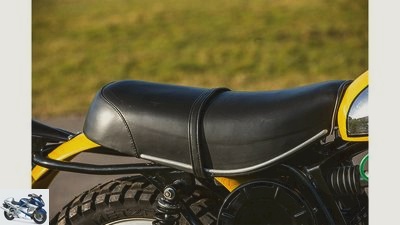
Rivas
28/33
Ducati Scrambler 450.
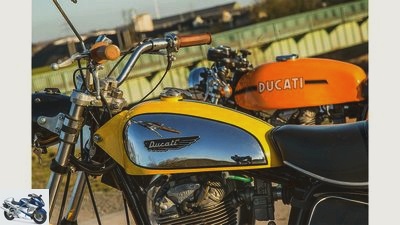
Rivas
29/33
Ducati Scrambler and Desmo.
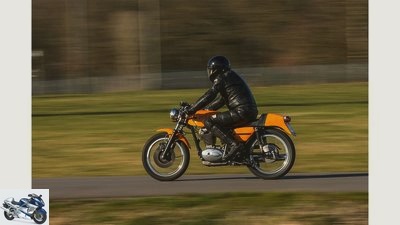
Rivas
30/33
This Ducati Desmo 450 made it to Germany via Hong Kong and England.
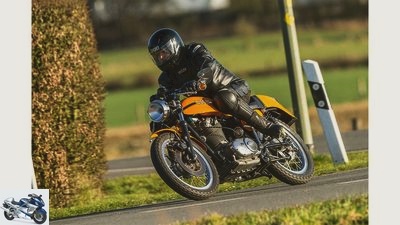
Rivas
31/33
Only in this bright yellow did it appear in its last version, …
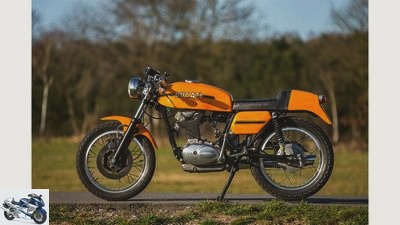
Rivas
32/33
… with window at the front and hump-fender combination at the rear.
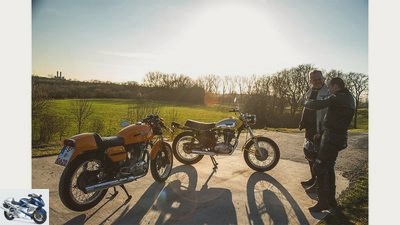
Rivas
33/33
… there is a lot to tell: Michael Scheidner (right) and author Fred Siemer try their hand at a resume in the article.
On the move with Ducati Desmo 450 and Ducati Scrambler 450
Racy athlete meets strong all-rounder
Content of
US importer Joe Berliner demanded more displacement, more power, more prestige, and Ducati delivered two big singles at the end of the 1960s: the Ducati Desmo 450 and the Ducati Scrambler 450.
The terms D.ucati and scrambler like to be accommodated in the same breath. These beautiful words were very close 50 years ago. At least in Italy and North America, because there, multifunctional motorcycles named like this, though equipped with one instead of two cylinders, went far better than their street-sport-oriented sister models.
Buy complete article
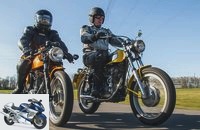
On the move with Ducati Desmo 450 and Ducati Scrambler 450
Racy athlete meets strong all-rounder
Widecase engine debuted in 1967
In the autumn of the same year, the newly designed, so-called widecase engine made its debut at the trade fairs in London and Milan, the mechanically stronger design of which made Berliners dream of new displacement dimensions. Before that, however, the creator of this hot single allowed himself to fulfill his very personal dream. For a long time Fabio Taglioni, who switched from Mondial to Ducati in 1954, wanted to equip a series engine with desmodromic valve control after the brilliant Bialbero 125 launched in 1956. Now, at last, he had a healthy basis for higher speeds and more power, in 1968 he cheerfully dared what has graced Ducati since then and to this day: In the 250 and 350 Mark 3D athletes, the D stands for Desmodromic.
One rocker arm per valve opens and one closes, actuated by four narrow cams located close together. Valve springs are used to close before the start and can be much weaker. A year later, of course, Berliner got what he wanted. A bore of 86 millimeters with a stroke of 75 millimeters (as with the 350) results in exactly 435.7 cm³ – the largest Ducati series engine of all time was born. It was soon found as a spring motor both in the scrambler chassis and in the road frame, with D for Desmo, the 450 Mark 3D crowned the model range.
Ducati’s best-selling was the Scrambler
Scramblers were popular, at least in the USA and Italy. The Ducati athletes, on the other hand, relied on real enthusiasts who didn’t want to be important, but wanted to be fast. On country roads, on winding courses. Just because of their narrow hedge paths, but also thanks to Mike Hailwood’s successes with the 125cc Desmo Racer and their active importers (one of whom was Mike’s father Stan), the British were among the most loyal customers, then the Italians themselves. Some German connoisseurs – served by Fritz Alexander from Neustadt am Rubenberge – also gratefully accepted, and Joe Berliner did his best in the USA, but at the same time never tired of asking for more displacement and, above all, more cylinders. The result? They fully relied on the L-Twin, introduced in 1971, and production of the singles ended in 1974, allegedly due to a lack of space.
Forty years later, near Dorsten, on the very edge of the proletarian Ruhr area, the suspicion arises that the bosses could not have had all the cups in their cupboards back then. The sun smiles dry on all the streets, the sky puts everyone in a good mood, and under the narrow tank of the Ducati Scrambler 450 a single is making itself popular that would easily have cut a good figure even in the mid-80s. Why was he retired in 1974? Sounds energetic, steps up lively and purrs up like a bird. Splendid. Michael Scheidner marks the course in advance, on the way on a sparkling clean Desmo 450. Michael Nitzsche’s workshop manager & Team from Dorsten-Wulfen mainly takes care of Konigswellen-Ducs during working hours, and he also has the two pleasant singles in his care. So the man knows his way around – and he enjoys the objects of his work: the Ducati Desmo 450 can happily show what all the effort in your head should be for. For safe high speeds.
Rivas
Then as now, welcome: Ducati Scrambler.
But Michael just wants to play. The Ducati Scrambler 450 can follow without great effort, the thoughts take their own course. Where were these Ducatis 40 years ago? Technically, they surpassed everything that the rest of Europe could offer in this displacement class. Overhead camshaft driven by a vertical shaft, compact power unit with five-speed gearbox, stable and handy chassis. Forced control on the street model on top. At the same time, they were really tricky in terms of production technology, the assembly of the complicated engine drove the price of the Ducati Desmo 450 (1973: 3900 marks) far above that of the high-performance Japanese competitors, such as the very popular Honda CB 350 (3350 marks) or the Yamaha DS 7 (3250 Mark).
The spring motor also took its time because of the elaborately mounted and neatly spaced vertical shaft. Nevertheless, the Scrambler cost a lot less, was not far from the first enduro offers from the Japanese, which also called for well over 3,000 marks for a Honda XL 250 or a Kawasaki 350 Big Horn. Two years after the end of Ducati’s singles, Yamaha opened a huge barrel and reinvented the all-round motorcycle with the XT 500. Ducati could have done that too, the Scrambler was only missing a few centimeters of travel.
Choke lever sits on the handlebar
Damn it. Accidentally switched up. You shouldn’t let your thoughts fly if you only use a clockwise gearbox every few months. In this case, by the way, it is very easy to switch and sufficiently precise. After three or four traffic lights even the idle search works perfectly. Anyway, this Ducati convinces with extremely friendly manners: the choke lever sits on the handlebar, the kick starter mounted on the left of the engine housing is well translated, the valve lifter peeps out under the clutch lever on the left and helps over top dead center – the cold start loses its horror, but also warm or warm (always without choke) the engine starts up well.
The clutch is much smoother than on old Ducati twins, and much is an understatement in this regard. The model that was driven lacks the standard instrumentation with a rev counter, but the two-valve engine does its best from a presumed 2000 to 2500 tours. Nicely predictable, precisely metered using the 29 VHB Dellorto carburettor. This is followed by a lively mid-rev range, and the Ducati Scrambler 450, which weighs only 145 kilograms with a full tank, is really fast even by today’s standards. It is a shame that no XT 500 was available, looking at it from memory, you could hang it out with this old Duc.
Full hub brakes are not much good
But don’t slow down, because the Italian’s full-hub brakes are just as bad as the Yamaha half-hubs. No matter. Those who prefer species-appropriate use can let the Ducati Scrambler 450 run comfortably anyway – and thus survive even rough road sections. In particular, the struts, which are also not standard, pass on unfiltered what the winter left with frost onset. The Ceriani fork, on the other hand, makes you cozy. Which, in turn, suits a sitting position that, with the footrests placed quite far forward and low, as well as a wide and oncoming handlebar, hardly encourages you to take the knife between your teeth. And offroad? Riding while standing somehow works better on every Nippon Enduro, so let’s leave that aside: this Scrambler is no more off-road than a reasonably light street motorcycle. But nicer.
And that would be the crux of the matter. Even the strange swing in the seating, which always wedges the driver in a little, is forgiven from four meters away and found it graceful. Harmonious form and robust charisma have seldom entered into a more beautiful liaison. Only the very long standard silencer looks incorrectly proportioned, which is why it is missing here: The replacement, actually reserved for US exports, sounds better and – according to Michael Scheidner – contributes significantly to the lively character of this spring motor. Of course, the Desmo engine reacts even more liberally to the rapid disposal of its combustion products. Ernst “Klacks” Leverkus experienced this as early as 1969 when he chased a 250 Mark 3D around the Nurburgring and after a few laps wanted to try out the megaphone that was supplied as standard, but which is of course not allowed in traffic. So screwed the thing in, bigger main jet into the carburetor, suction hose removed, bigger pinion on and off. The good Ernst was amazed and wrote in MOTORRAD: “Then it was as if you had actually pulled a cork out of the bottle. Half a minute of profit per lap straight away! ”Ducati did not provide official performance data for this configuration, but with all of its experience and all its possibilities for comparison, Klacks estimated around 27 hp. For a late 1960s 250. Thunderstorm.
The Desmo engine runs much quieter
Although the Ducati Desmo 450 doesn’t sound too buttoned up under Michael Scheidner, the mechanic doesn’t trust it to exceed 33 hp. “A decent 350 is damn close to the big one, and it brings in a good 30”, he explains and cannot hide the fact that the spontaneous revving of the middle unit really turns him on. But the 450 has a nice train. Increases irresistibly and comes out of the cellar well – almost like the spring buddy in the Ducati Scrambler 450 with its shorter gear. Above all, it surprises in direct comparison with its extremely smooth running. If you listen correctly, you will have half understood the desmodromic: Because the mechanics do not have to deal with the considerable counter-pressure of the hairpin springs, it just purrs from the cylinder head.
No hard ticking, nothing at all, even though the Desmo (0.1 – 0.15 mm) on the opening rocker arm should even have a touch more valve clearance than the spring motor (0.05 – 0.10 mm). The Desmo was not supposed to convince its drivers with its smoothness, but with performance, which is why Fabio Taglioni used the possibilities of the positive control, which he valued so much, and prescribed significantly longer valve opening times. Because there was no need to worry about fluttering, the valve and piston crown could never come too close, not even during the 10,000 tours, which were insane for the circumstances, that Leverkus squeezed out of the opened 250 cc in the Fuchsrohre. Ergo the valves could open longer. In addition, the precise control allows steeper cam profiles, so the valves open faster on top of that.
Street models in 1971 split into two rows
Great prospects for all sporty drivers. And they got even better when Ducati split the street models into two rows in 1971. The spring motors remained in the familiar environment and henceforth served the touring segment. The Desmos, on the other hand, appeared completely new. Away with everyday fuss, here with a one-man hump and set back footrest system. Of course, there was no longer an optional antler handlebar, instead tank and body parts made of GRP as standard.
Grimeca supplied a sharper brake, Borrani nice light alloy high-shoulder rims and Marzocchi contributed a 35 mm fork. The slim line is said to come from Leopoldo Tartarini, the ex-works driver and later Italjet founder. Because of its generally silver finish, the lighter was quickly called the Silver shotgun. A bright yellow, the one-piece hump-fender combination, a steel tank as well as the introduction of a Brembo disc brake and the change to the 35 mm Ceriani fork accompanied the last lifting of the Ducati Desmo 450 in 1973.
Rivas
The Desmo 450 runs much smoother.
Another encouraging blow, then Michael Scheidner hands the handlebars over. Fortunately, because when kicking off the Ducati Desmo 450 is a little diva. You have to know their ticks to be quick and dry at the right point, and by the way, no valve lifter can help. So keep the baby happy and sort the limbs. Works very well at the top, so the long tank is very convenient for all drivers who are more than 185 centimeters tall. It’s getting tighter at the bottom. But the levers – the one on the left for the brake has to be folded up to kick in just like the footrest – are well adjusted. So right up and down the post. Despite the identical gearbox, the first gear is quite long compared to the Ducati Scrambler 450 due to the different secondary gear ratio, but the single-cylinder bridges this genetic shortcoming with surprising elasticity. Must be on the racetrack, and that’s exactly where the Desmo head was specifically developed to be ready for series production from 1966.
The gears locked precisely, the needle of the rev counter driven by the camshaft hurried across its small dial. From 3500 rpm, music really plays here, and above 7500 it increases to a furioso. And that’s still only half the battle, because without its wonderful chassis the engine could still spin like that. Only thanks to a torsion-resistant frame, crisp spring elements, extremely easy handling and timeless directional stability does the whole thing turn into a sports motorcycle. Wait, not to forget the low weight: around 140 kilos ready to drive with a full 13 liter tank. No high-flyer grows out of all this. Here, too, one would like to have a contemporary Yamaha ready, a good RD 250 for example with six gears and battle-tested secondary transmission, in order to really scrutinize the Ducati. But even on the RD, the long-term memory whispers, the curve swing was somehow more strenuous. Only a lightweight like the Ducati Desmo 450 can convey this freedom to change direction with the slightest tug of the handlebar and the most gentle pressure on the thighs. And that sticks at the end of a wonderful day: pounds cost freedom.
![]()
Modern Classic
Ducati Scrambler Icon in the driving report
Vehicle or attitude to life?
read more
Technical data Ducati Scrambler 450 / Ducati Desmo 450
Rivas
Two worlds, one basic construction: Scrambler and Desmo sometimes in lockstep.
Ducati Scrambler 450 (in brackets: Ducati Desmo 450)
Engine:
Air-cooled single-cylinder four-stroke engine, one overhead camshaft, two valves, operated via rocker arm (opening and closing using rocker arm), displacement 436 cm³, power approx. 27 (30) HP at 7000 / min (7500 / min)
Power transmission:
Multi-disc oil bath clutch, five-speed gearbox, chain drive
Landing gear:
Frame made of tubular steel open at the bottom, telescopic fork at the front, swing arm with two spring struts at the rear, tires front 3.50 x 19 (3.25 x 18), rear 4.00 x 18 (3.50 x 18), simplex drum brakes front and rear (front disc brake, rear drum)
Mass and weight:
Wheelbase 1380 (1360) mm, tank capacity 11 (13) liters, weight 145 (140) kg
Top speed:
140 (160) km / h
price
Ducati Desmo 450 1973: 3900 marks;
Ducati Scrambler 450 not offered in Germany
In the check – technology, market, dealers
Rivas
In the course of its inevitably long life, a single-cylinder Ducati offered today should have had a thorough look through its electrical system.
technology
Rivas
The cylinder head and vertical shaft drive of a Desmo single consist of around 200 individual parts. This exploded view shows its control side, it is very nice to see the complicated precision mechanics required by the closers of the valves. The hairpin springs are mainly used to safely close the valves before starting.
Based on one and the same basic construction – that of the racer 100 Gran Sport “Marianna” presented in 1955 – Ducati’s single-cylinder bevel shafts climbed the displacement ladder very slowly. In 1957 they reached 175 cc in series, then 250 cc in 1961 and finally 350 cc in 1965. But with that the possibilities of the case were completely exhausted. In order to regain a solid base and to be able to offer even more displacement, Fabio Taglioni developed a brand new engine whose housing and gearbox were to share all 250 and 350, and later also the 450 variants. This single-cylinder, baptized widecase motor, has an oil content that has been increased from 2 to 2.5 liters and is significantly wider than its predecessor in the area of the rear motor mount.
Therefore, some changes were necessary to the frame, which still works with one main tube, is guided twice at the rear to the swing arm mount and is open at the bottom. A larger crankshaft bearing on the drive side as well as a stronger crank pin and an improved kick starter mechanism increase the inner values. Taglioni has developed the Desmo head from scratch, which crowned the street models from 1968 onwards, but was also used in some enduro bikes suitable for competition such as the R / T from 1970. The very last scramblers from the very, very last weeks of production also wore it. While many parts are compatible between the 250 and 350 series, the 450 series not only differs in its head, cylinder and crankshaft, but also in its housing.
Purchase check
In the course of its inevitably long life, a single-cylinder Ducati offered today should have had a thorough look through its electrical system. In fact, it was never special in series production. Clever contemporaries then upgraded to 12 volts. The main weaknesses of the engines are the second gear pair and the crankshaft. The former often suffers from broken teeth, which is indicated by singing noises while driving. This defect will reappear where the claws have not been properly ground back afterwards. The crankshaft sucks under the lower connecting rod eye, which is too narrow, especially with the large-displacement variants, where enormous forces occur and destroy the bearing surfaces, which are then noticeable with nailing noises when accelerating.
Wider connecting rods, such as those used in the R / T, help in the long term. Available from the active scrambler friends from Italy (see specialists). The spring heads often show damage to the rocker arm running surfaces. The 450 engine responds to the installation of the lighter piston of a 900 SS with a smoother run and greater revving. Experienced mechanics also mill the valve seats slightly so that there are better flow conditions immediately after opening. In general, mechanic: The Desmo head in particular requires a lot of experience.
market
The market for Desmo models is largely exhausted, accordingly the prices for particularly popular models with 350 or 450 cm³ have now reached over 10,000 euros. The 250 comes a little cheaper. In principle, scramblers are around 2500 to 3000 euros less.
Specialists
Michael Nitzsche & team
in 46286 Dorsten-Wulfen
www.italomotos.de
Andreas Nienhagen
in 70736 Fellbach
www.desmo.net
Moto Club Amici dello Scrambler
www.ducatiscrambler.com
history
Rivas
1969: The 450s are added to the range.
1967: The revised single-cylinder is presented in the fall and comes on sale the following spring in Scrambler and Mark 3 models, initially only as 250 and 350.
1968: Ducati offers the desmodromic valve control as standard for the first time, in the Mark 3D models.
1969: The 450 makes its debut, both street and scrambler versions. At the same time, a – never produced – 500 parallel twin with an underneath camshaft was also being developed, hence the displacement restriction.
1971: The Desmo 250 to 450 models appear radically sporty and are at the top of the Ducati single-cylinder range.
1974: End of production of the Ducati single cylinder.
Opinions
Rivas
Michael Scheidner (right) and author Fred Siemer try their hand at a resume in the article.
Fred Siemer
seldom drives vertical shafts, but loves to do so.
The master has proven it to me again: He creates something special. In the case of his single cylinder, I don’t mean the technical effort, but what comes out in the end. Fabio Taglioni’s 450s do not do art for art’s sake. No, sophisticated mechanics create practical qualities here. In the case of the Ducati Desmo 450, a sensational performance development for the time, and in the case of the Scrambler an engine characteristic that could still serve as a blueprint for light enduros today. The best part: With motorcycles in early retirement, not even the short inspection intervals and the considerable vibrations at continuous speeds are a problem.
Michael Scheidner
always and still likes to screw on vertical shafts.
In the workshop, a vertical shaft motor, especially with a desmodromic, is a challenge, of course. But it is precisely because of such challenges that you become a mechanic. Distancing the bevel gears, setting the valve clearance – even inspections are never boring, not to mention the assembly of a completely dismantled valve train. But that’s only one side, the driving pleasure the other. A few knowledgeable modifications are enough, and a Desmo develops a willingness to perform that was incomparable for the circumstances at the time. The 350 engine can do this best: even more revving than the 450, much fuller than the 250. A stunner.
Related articles
-
Ducati Scrambler Icon in the PS performance test
andreasriedmann.at 18 pictures andreasriedmann.at 1/18 Ducati Scrambler Icon in the PS performance test. andreasriedmann.at 2/18 Ducati Scrambler Icon in …
-
Yamaha XSR 700 and Ducati Scrambler retro bikes in comparison
28 pictures Rossen Gargolov 1/28 Twice conversion optics ex works in the lower middle class, two times 75 HP, full beard and …
-
On the move with Ducati 860 GTS and Norton Commando 850
fact 32 photos fact 1/32 Ducati 860 GTS and Norton Commando 850 on the move. fact 2/32 Ducati 860 GTS and Norton Commando 850 on the move. archive 3/32…
-
Ducati Scrambler Sixty2 and Moto Guzzi V7 II Scrambler in comparison test
markus-jahn.com 17 pictures markus-jahn.com 1/17 picture gallery: Impressions of small scramblers. markus-jahn.com 2/17 Ducati Scrambler Sixty2 and Moto Guzzi …
-
Ducati Scrambler Sixty2 in the driving report
Ducati 24 pictures Ducati 1/24 Ducati Scrambler Sixty2. Ducati 2/24 Ducati primarily wants to reach young people with the 400 series. Ducati 3/24 Federico …
-
Ducati Scrambler 1100 Special top test
factstudio.de 19 pictures factstudio.de 1/19 Top test of the Ducati Scrambler 1100 Special. factstudio.de 2/19 Looking for tenths on a hang-off that …
-
markus-jahn.com 37 pictures markus-jahn.com 1/37 Ducati Scrambler. markus-jahn.com 2/37 Ducati Scrambler. markus-jahn.com 3/37 Ducati Scrambler ….
-
Ducati Scrambler Icon in the top test
markus-jahn.com 28 pictures markus-jahn.com 1/28 Ducati Scrambler Icon. Manufacturer 2/28 Competition: Moto Guzzi V7 II Stone: two-cylinder V-engine, 48 hp, …
-
New Items 2019 Top Topic Ducati 19 Pictures Ducati 1/19 Ducati is giving the Scrambler Icon some updates in the 2019 model year. Ducati 2/19 On a first …
-
Impressions BMW R nineT Scrambler, Ducati Scrambler and SWM Silver Vase 440
fact 16 pictures factstudio.de 1/16 It’s done in a moment. Only a few hundred meters and the three scramblers have the chapter of paved paths behind …